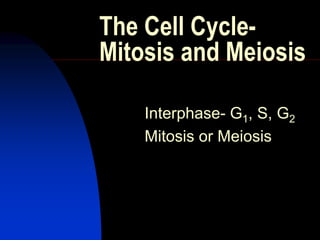
Mitosis and Meiosis.ppt
- 1. The Cell Cycle- Mitosis and Meiosis Interphase- G1, S, G2 Mitosis or Meiosis
- 2. The Cell Cycle The sequence of growth and division of a cell
- 4. Interphase = G1, S, G2 Interphase is when the cell grows, and the organelles double prior to the actual splitting of the nucleus. 93% of a cell’s life is spent in interphase. Interphase has three parts Growth 1 (G1) Synthesis (S) Growth 2 (G2)
- 5. G1, S, G2 G1 is when organelles double. Remember each new cell needs a complete set of organelles. S when DNA is replicated. Each cell needs a complete and identical set of DNA G2 Proteins needed for Mitosis are produced.
- 6. Mitosis The process by which the cell nucleus divides into two identical cell nuclei. In some Human cells interphases lasts 15.3 hours, while mitosis lasts only .7 hours. Occurs in a series of steps Prophase Metaphase Anaphase Telophase Cytokinesis
- 7. Chromosomes Must duplicate and separate during Mitosis Structures of the tightly packaged DNA DNA is tangled up into a substance of chromatin The chromatin is packaged on the chromosome
- 9. Prophase Chromosomes now called chromatids because they doubled to form short thick rods which pair up and line up in the center of the nucleus. A centromere connects the two halves of the doubled chromatids. Spindle fibers begin to form. Spindle fiber – a fibrous structure from the cytoplasm which forms to the centriole. Centrioles move to opposite sides of the cell. The nuclear membrane breaks down.
- 10. Prophase
- 11. Metaphase Centromeres of the chromatid pairs line up in the middle of the cell. Metaphase plate- location where the centromeres line up in the center of the cell. By the end of metaphase each chromatid has attached to spindle fibers.
- 12. Metaphase
- 13. Anaphase The spindle fibers pull the chromatids apart. This separates each one from its duplicate. These move to opposite sides of the cell. Now there are two identical sets of chromosomes.
- 14. Anaphase
- 15. Telophase When the chromosomes reach opposite sides of the cell the spindle fibers break up. The nuclear membrane begins to reform. A furrow begins to develop between the two sets of chromosomes.
- 16. Telophase
- 17. Cytokinesis The two identical cells completely divide and the cell membrane is completely formed.
- 18. Mitosis Movie 1
- 19. Mitosis movie 2
- 20. Meiosis Diploid (2n) - A cell with two of each kind of chromosome. One chromosome from each parent. If two body cells were to combine nuclei, the number of chromosomes would double. In order for sexual reproduction to occur, each cell involved must reduce its chromosome number by half. Haploid (n)- A cell with one of each kind of chromosome.
- 21. Haploid cells Haploid cells are called gametes Gametes are either sperm or eggs Organism diploid gamete Human 46 23 Pea 14 7 Fruit fly 8 4 Dog 78 39
- 22. Homologous chromosomes Are paired chromosomes with genes for the same trait arranged in the same order. Ex. Eye color, hair color, height, one may code for blue, blonde, tall, its homolog may code for brown, blonde, short Homologous chromosomes may have different alleles on them Allele- gene form for each variation of a trait of an organism.
- 23. Meiosis Meiosis is the process of cell division in which gametes are formed and the number of chromosomes is halved. So that sexual reproduction and zygote formation can occur. Zygote- Fertilized egg which has a diploid number of chromosomes.
- 24. Stages of Meiosis Interphase- Chromosomes replicate Each chromosome consists of 2 identical sister chromatids Prophase I Each Pair of homologous chromosomes come together to form a tetrad. Tetrad- 2 homologous chromosomes come together and the 4 chromatids overlap.
- 25. Crossing over Tetrads are so tight that non-sister chromatids from the homologous pair actually exchange genetic material. Crossing over- The exchange of genetic material by non-sister chromatids during late prophase I of meiosis. Results in a new combination of alleles
- 26. Metaphase I Homologous chromosomes line up together in pairs. * In mitosis homologous chromosomes line up in the middle independently of each other.
- 27. Anaphase I Spindle fibers attach to the centromeres of each pair. Homologous chromosomes separate and move to opposite ends of the cell. Centromeres DO NOT split like they do in mitosis Now each cell will get one chromosome from each homologous pair.
- 28. Telophase I Spindle fibers break down Chromosomes uncoil Cytoplasm divides Another cell division is needed because the number of chromosomes has not been reduced After telophase I there maybe a short interphase, but not always. It is important to note that if a cell does have a second interphase, there is No replication of chromosomes.
- 29. Meiosis I
- 30. Meiosis II Is basically just like mitosis, but remember the chromosomes did not duplicate in interphase II. Prophase II Chromosomes begin to line up in the middle of the cell. Spindle fibers begin to form Metaphase II Chromosomes line up on the metaphase plate
- 31. Meiosis II Anaphase II Centromeres split Sister chromatids separate and move to opposite sides of the cell Telophase II Nuclei reform Spindle fibers disappear Cytoplasm divides into two. The number of chromosomes in each daughter cell has now been reduced by half.
- 32. Meiosis II
- 33. Meiosis Movie 1